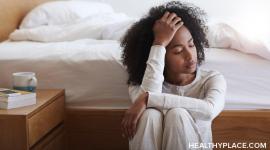What Are the Symptoms of Depression and Depressive Disorder?
The depressive disorder symptoms are common when considered in isolation but constitute an illness when depression symptoms occur in a group. For example, many people experience sleep disturbance (oversleeping or undersleeping) and taken alone, this is not a mental illness, but when that occurs for a certain length of time in combination with other symptoms, like a depressed mood and a lack of interest in previously enjoyed activities, among others, it becomes known as major depressive disorder. Major depressive disorder symptoms are defined in the Diagnostic and Statistical Manual of Mental Disorder, Fifth Edition (DSM-5).
Major Depressive Disorder Symptoms
Major depression, also known as major depressive disorder or MDD, is diagnosed when five or more of the following happen during the same two-week period (at least one must be diminished interest or pleasure or depressed mood):
- Depressed mood (for children and adolescents, this can also be an irritable mood)
- Diminished interest or loss of pleasure in almost all activities (anhedonia)
- Significant weight change or appetite disturbance (for children, this can be failure to achieve expected weight gain)
- Sleep disturbance (insomnia [sleeping too little] or hypersomnia [sleeping too much])
- Psychomotor agitation (anxious restlessness that can cause involuntary movements, among other things) or retardation (psychological and physiological slowing)
- Fatigue or loss of energy
- Feelings of worthlessness
- Diminished ability to think or concentrate; indecisiveness
- Recurrent thoughts of death, recurrent suicidal ideation without a specific plan, or a suicide attempt or specific plan for committing suicide

Other Depressive Symptoms
While major depressive disorder symptoms are the most common, there are other depressive disorders that have their own specific symptoms. Examples include:
- Depression with anxious distress – contains additional depressive symptoms like feeling keyed up or restless or a fear that something awful will happen, among others
- Depression with melancholic features – contains additional depressive symptoms like excessive guilt or waking up two hours earlier than usual, among others
- Depression with catatonia – contains additional depressive symptoms like grimacing, stupor (near unconsciousness), or exhibiting extreme negativity, among others
- Atypical depression – contains additional depressive symptoms like rejection sensitivity or feelings of heaviness in the arms, among others
- Major depressive disorder with psychotic features – contains additional depressive symptoms like hallucinations and delusions
Other Depressive Disorders
In addition to the above depressive disorder specifications, there are other depressive disorders that contain the same symptoms of major depressive disorder but act in unique ways. Examples of this include:
- Postpartum depression – a depressive disorder that occurs after the birth of a baby; peripartum onset depression (depression that begins while pregnant) can also occur
- Seasonal affective disorder (SAD) – a depressive disorder that occurs only at a specific time of year (usually winter) with full remission occurring at another time of year (usually summer)
- Recurrent brief depression – a depressive disorder with frequent, short-lasting (usually only a few days), severe depressive episodes
- Short duration depressive episode – a depressive disorder with a shorter duration than two weeks
- Depressive episode with insufficient symptoms – a depressive disorder that does not meet the specific criteria for any of the above disorders
APA Reference
Tracy, N.
(2021, December 30). What Are the Symptoms of Depression and Depressive Disorder?, HealthyPlace. Retrieved
on 2025, December 10 from https://www.healthyplace.com/depression/symptoms/depression-symptoms-what-are-the-symptoms-of-depression



